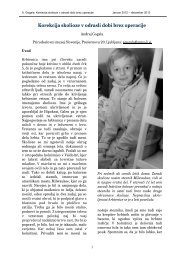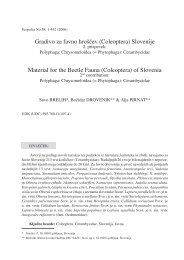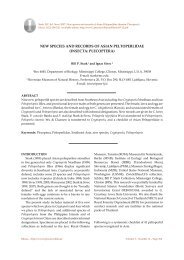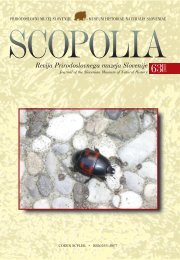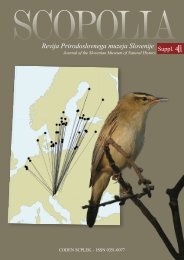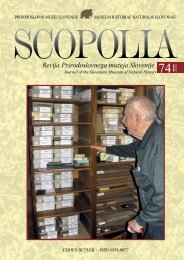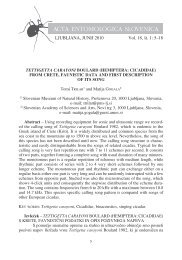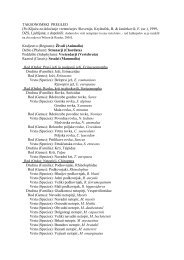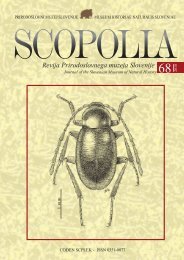Acta entomologica slovenica, 14 (1), 2006latipennis Curtis. Vrsta Rhyacophila dorsalis Curtis je izbrisana iz seznama innadomeøœena z alopatriœno vrsto R. nubila Zetterstedt. Ena vrsta (Stenophylaxlatipennis) in ena podvrsta (Stenophylax vibex speluncarum) sta bili umaknjenizaradi napaœne doloœitve in pomanjkanja podatkov. Vrsta Drusus serbicusMarinkoviå je endemiœna v Srbiji, medtem ko so Crunoecia bosniaca Marinkoviå-Gospodnetiå, Rhyacophila bosnica Schmid in Rhyacophila vranitzensis Marinkoviået Botosaneanu endemiœne vrste zahodnega Balkana.KLJUŒNE BESEDE: Trichoptera, favna, Srbija, liœinke, gorske rekeIntroductionCompiling of the list of Trichoptera of Serbia began with faunisticalinvestigations of Radovanoviå (Radovanoviå 1931; 1935; 1953). It was continued byMarinkoviå-Gospodnetiå (Marinkoviå-Gospodnetiå 1975; 1980) and due to theirwork 154 species of Trichoptera were determined in the fauna of Serbia.Having in mind the geographic position of Serbia on the Balkan Peninsula, andthe fact that four faunistical zones of the freshwater fauna of Europe contact eachother on its territory (Botosaneanu and Malicky, 1978), much more than 154 specieswere expected in the territory. In the west, the Dinaric system of mountains and areawest of the Vardar-Morava line belong to zone 5; the south-western part of Serbiawith Øarsko-Pind system belongs into the zone 6 together with Macedonia, Albaniaand Greece; the part of Serbia east of the above mentioned line together withBulgaria is in zone 7, and the area north of the Sava and Danube Rivers, i.e., thePannonian lowland, belongs to the zone 11. The richness of the Trichoptera speciesmay also be expected in the fauna of Serbia due to great habitat diversity. In the northof Serbia there is a vast Pannonian plain, and its still waters are inhabited by a faunasignificantly different from one that inhabits mountainous parts south of the Savaand the Danube. This plain is a natural barrier which separates mountainous parts ofSerbia from the central European mountains preventing direct mixture of theirfaunas. However, the mountains of eastern Serbia are linked to the mountains ofcentral Europe via the mountains of the Dinarides and the Alps, which to a certainextent open routes to migrations of the species between the mountains of centralEurope and the Balkans. Between the Balkan-Carpates arch of mountains in thenorth-eastern part and the Dinarides in the west, there are old Rodopes which stretchfrom the southeast. As a consequence of all abovementioned, certain regions of theBalkans are inhabited by Trichoptera fauna, which has a considerable percentage ofendemic species, many of which occur in a very small area. Also, it has been foundthat many endemic species of the Dinarides are closely related to endemic species ofthe Carpathians and that these species are allopatric (Marinkoviå-Gospodnetiå,1978).Since the publication of the first list of Trichopteran fauna in 1980 (Marinkoviå-Gospodnetiå 1980), research on Trichoptera, primarily larvae, has undergoneintensification in Serbia. This has contributed significantly to our understanding of56
Ivana Æiviå, Zoran Markoviå, Miloje Brajkoviå: Contribution to the faunistical list of Trichoptera (Insecta) of Serbiathe relationships of families, genera, and species. Specimens were collected inwestern, eastern and southeastern parts of Serbia from springs (from 1989 to 1996),rivers and brooks (the fletinja river in 1988, the Kriveljska river in 1995, theKolubara, Obnica, Jablanica and Gradac rivers and the river Banja from 1991to1995; the Kudoøki and Jelenaœki brooks from 2000 to 2001). Trichoptera larvaewere studied with the aid of keys for determination (Lepneva 1964, 1966; Sedlak1980; Waringer and Graf 1997; Wallace et al., 2003). The results of theseinvestigations were presented in the first faunistical list (the data from Simiå 1993;Simiå and Simiå 2003; Martinoviå-Vitanoviå et al. 1998, and Paunoviå, 2001 werealso incorporated), where findings of 19 species new to the fauna of Serbia werereported, the total number of Trichoptera species then being 173 (Æiviå et al. 2002).Since Serbia has a central position on the Balkans and four limnofaunistic zonesmeet in it, the study of Trichoptera fauna of Serbia may be a contribution to theknowledge of the history of the aquatic organisms on the Balkans and in the southeasternEurope. With this in mind, studies on Trichoptera, primarily larvae, werecontinued during the period of 1998-2003 in rivers of the watershed of the SouthernMorava, where 92 species were found (Æiviå 2005). Investigations were also carriedout in highland streams of Serbia during the period of 2001-2004. Thus, 20 specieswere recorded in the Toplica river (Æiviå et al. 2002a), 17 species in the Gazradskariver and its tributaries (Æiviå et al. 2004), six species in the Borkovaœki brook (Æiviået al. 2004a) and 14 species in the Treønjica river (Æiviå et al. 2004b). There are alsoworks dealing with the vertical distribution and range of Trichoptera larvae in riversof Serbia (Æiviå and Markoviå 2005).Results and DiscussionThe revised checklist of the Trichoptera fauna of Serbia (Tab. 1) includes 19families, 70 genera, and 186 species. In relation to the first list, the genera Chimarra,Melampophylax, and Oecetis are new to the fauna of Serbia. In the present list, thenumber of species found has risen to 186, which is a consequence of inclusion of 13species of Trichoptera new to the fauna of Serbia (at the larval stage, indicated in thepaper by an asterisk and filled diamond sign*®; the findings of these species needconfirmation by collection of adults, which is planned in the future investigations):Rhyacophila torrentium Pictet, 1834; Rhyacophila glareosa McLachlan, 1867;Rhyacophila intermedia McLachlan, 1868; Glossosoma conformis Neboiss, 1834;Chimarra marginata Linnaeus 1767; Cyrnus flavidus McLachlan, 1864;Brachycentrus subnubilus Curtis, 1834; Ecclisopteryx madida McLachlan, 1867;Melampophylax mucoreus Hagen, 1861; Micropterna lateralis Stephens, 1874;Grammotaulius nigropunctatus Retzius, 1783; Oecetis testacea Curtis, 1834;Micrasema longulum McLachlan, 1876. Moreover, since publication of the previouslist, larval forms of eight species have been found in addition to adults: Rhyacophilalaevis Pictet, 1834; Wormaldia occipitalis Pictet, 1834; Cyrnus trimaculatus Curtis,1834; Brachycentrus montanus Klapalek, 1892; Drusus biguttatus Pictet, 1834;57
- Page 1:
Vsebina / ContentsL. SENŒIŒ: Inte
- Page 4:
ISSN 1318-1998CODEN: AESLFMUDC (UDK
- Page 7 and 8: ACTA ENTOMOLOGICA SLOVENICALJUBLJAN
- Page 9 and 10: Leon Senœiœ: Intensity of wing pi
- Page 11 and 12: Leon Senœiœ: Intensity of wing pi
- Page 13 and 14: ACTA ENTOMOLOGICA SLOVENICALJUBLJAN
- Page 17 and 18: Gabrijel Seljak: An overview of the
- Page 19 and 20: Gabrijel Seljak: An overview of the
- Page 21 and 22: Gabrijel Seljak: An overview of the
- Page 23 and 24: Gabrijel Seljak: An overview of the
- Page 25 and 26: Gabrijel Seljak: An overview of the
- Page 27 and 28: Gabrijel Seljak: An overview of the
- Page 29 and 30: Gabrijel Seljak: An overview of the
- Page 31 and 32: Gabrijel Seljak: An overview of the
- Page 33 and 34: Gabrijel Seljak: An overview of the
- Page 35 and 36: Gabrijel Seljak: An overview of the
- Page 37 and 38: ACTA ENTOMOLOGICA SLOVENICALJUBLJAN
- Page 39 and 40: Bojan Kofler: Anophthalmus miroslav
- Page 41 and 42: Bojan Kofler: Anophthalmus miroslav
- Page 43 and 44: Bojan Kofler: Anophthalmus miroslav
- Page 45 and 46: ACTA ENTOMOLOGICA SLOVENICALJUBLJAN
- Page 47 and 48: Tone Lesar, Matjaæ Jeæ: Prispevek
- Page 49 and 50: Tone Lesar, Matjaæ Jeæ: Prispevek
- Page 51 and 52: Tone Lesar, Matjaæ Jeæ: Prispevek
- Page 53 and 54: Tone Lesar, Matjaæ Jeæ: Prispevek
- Page 55 and 56: Tone Lesar, Matjaæ Jeæ: Prispevek
- Page 57: ACTA ENTOMOLOGICA SLOVENICALJUBLJAN
- Page 61 and 62: Ivana Æiviå, Zoran Markoviå, Mil
- Page 63 and 64: Ivana Æiviå, Zoran Markoviå, Mil
- Page 65 and 66: Ivana Æiviå, Zoran Markoviå, Mil
- Page 67 and 68: Ivana Æiviå, Zoran Markoviå, Mil
- Page 69 and 70: Ivana Æiviå, Zoran Markoviå, Mil
- Page 71 and 72: ACTA ENTOMOLOGICA SLOVENICALJUBLJAN
- Page 73 and 74: Ljiljana Protiå: Nabidae (Heteropt
- Page 75 and 76: Ljiljana Protiå: Nabidae (Heteropt
- Page 77 and 78: Ljiljana Protiå: Nabidae (Heteropt
- Page 79 and 80: Ljiljana Protiå: Nabidae (Heteropt
- Page 81 and 82: Ljiljana Protiå: Nabidae (Heteropt
- Page 83 and 84: ACTA ENTOMOLOGICA SLOVENICALJUBLJAN
- Page 85 and 86: M Aydogdu, A. Beyarslan: First reco
- Page 87 and 88: M Aydogdu, A. Beyarslan: First reco
- Page 89 and 90: M Aydogdu, A. Beyarslan: First reco
- Page 91 and 92: ACTA ENTOMOLOGICA SLOVENICALJUBLJAN
- Page 93 and 94: Emine Demir: Preliminary report on
- Page 95 and 96: Emine Demir: Preliminary report on
- Page 97 and 98: Emine Demir: Preliminary report on
- Page 99 and 100: Emine Demir: Preliminary report on
- Page 101 and 102: Emine Demir: Preliminary report on
- Page 103 and 104: Emine Demir: Preliminary report on
- Page 105 and 106: Favnistiœni zapiski / Faunistical
- Page 107 and 108: Abdullah Hasbenli, Fatma Bayrakdar,
- Page 109 and 110:
Vabilo na Prvi slovenski entomoloø



